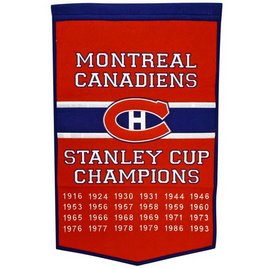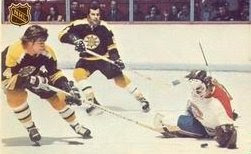 What you see here are nine Montreal Canadiens cards from 1911-12. In mint condition, judging by recent sales and auctions, the set might be worth a million!
What you see here are nine Montreal Canadiens cards from 1911-12. In mint condition, judging by recent sales and auctions, the set might be worth a million!Only the second ever set of hockey cards issued, the C55 1911-12 Imperial Tobacco series of 45 cards is a most sought after set.
The set contains many rookie cards and features 22 future Hall Of Famers, including four from the Montreal Canadiens.
 The C55 set is the most common of the three cards sets produced by Imperial Tobacco, who also issued the 1910-11 C56 series and the 1912-13 C57 set.
The C55 set is the most common of the three cards sets produced by Imperial Tobacco, who also issued the 1910-11 C56 series and the 1912-13 C57 set.The cards each feature colour drawing of photos taken from the day, and have brief player information on the reverse. The cards measure 1 1/2" by 2 1/2", and are an extremly rare find, especially in mint shape.
 Players in the 1911-12 set were members of the NHA's Quebec Bulldogs, Ottawa Senators, Montreal Wanderers, Renfrew Millionaires and Canadiens. The series, considered the Holy Grail of hockey card sets, is highly prized by collectors. Though it is the easiest of the three early Imperial sets to find, it is the most difficult to complete due to it's size.
Players in the 1911-12 set were members of the NHA's Quebec Bulldogs, Ottawa Senators, Montreal Wanderers, Renfrew Millionaires and Canadiens. The series, considered the Holy Grail of hockey card sets, is highly prized by collectors. Though it is the easiest of the three early Imperial sets to find, it is the most difficult to complete due to it's size.The highest priced card is #38 Georges Vezina which often sells at $1,650.00. The cards of Edouard "Newsy" Lalonde and Art Ross go for $800.00. Common cards, or non Hall Of Famers in the series, are rated at $100.00 each. The pricing are general for cards in the good to very good condition.
Other cards in the set include the Cleghorn brothers, Ogilvie and Sprague, Joe Hall, Jack Darragh, Cyclone Taylor, Riley Hern, Joe Malone, Didier Pitre, Jack Laviolette, Percy Lesueur and Tommy Dunderdale.
 I'm not sure when it began, but professional grading of cards has helped send issues in perfect condition into stratospheric sales prices. The grading includes ratings on the colour and tinge of the card, the quality and smoothness of the surface, the sharpness of it's four corners, and the squared alignment of it's borders.
I'm not sure when it began, but professional grading of cards has helped send issues in perfect condition into stratospheric sales prices. The grading includes ratings on the colour and tinge of the card, the quality and smoothness of the surface, the sharpness of it's four corners, and the squared alignment of it's borders.Cards are then graded from 1 to 10, docked a point for each imperfection. I am told that a card with more than more four imperfections does not receive a certifiable professional grading. It would then be considered to be in very good condition and perhaps quality due to it's rarety for the prices listed above.
 In August of 2006, a 1979 #18 Wayne Gretzky O-Pee-Chee rookie card sold for $80,000, making it the most valuable hockey card in existence at the time.
In August of 2006, a 1979 #18 Wayne Gretzky O-Pee-Chee rookie card sold for $80,000, making it the most valuable hockey card in existence at the time. 
Several months later the April 2007 issue of Beckett Hockey magazine published an article titled "The Greatest Card Ever Sold" focusing on the recent record setting $100,000 sale of a mint graded 1911-12 Georges Vezina hockey rookie card. The Honus Wagner baseball card is the most valuable sports card in history but legendary goalie George Vezina's rookie card is easily the most valuable hockey card to date.

Finding a mint hockey card from the C55 set is not always easy but even the lower grades of 2 or 3, which are more commonly found, command prices up to hundreds of dollars. The Georges Vezina rookie card would be the crown jewel of any hockey card collector's collection. In the years to come it will be interesting to see what the mint graded Vezina rookie will sell for if it ever goes to auction again.
 The Beckett Hockey Collector magazine reported in the September 2007 issue that a rare 1910-11 C56 Newsy Lalonde hockey card had tied the record, selling for $100K as well. The Newsy Lalonde hockey card was graded a 3 out of 10 by SCG, a sports card grading service.
The Beckett Hockey Collector magazine reported in the September 2007 issue that a rare 1910-11 C56 Newsy Lalonde hockey card had tied the record, selling for $100K as well. The Newsy Lalonde hockey card was graded a 3 out of 10 by SCG, a sports card grading service.There is no record of anyone having the entire 1911-12 set in top graded shape.
That would have to be worth a million?
.





















































































































































































